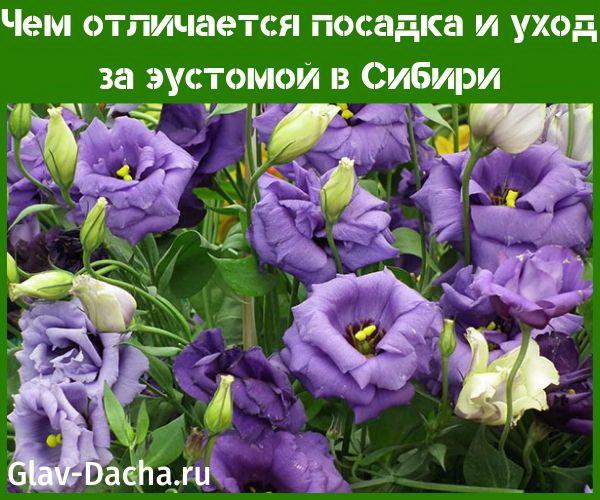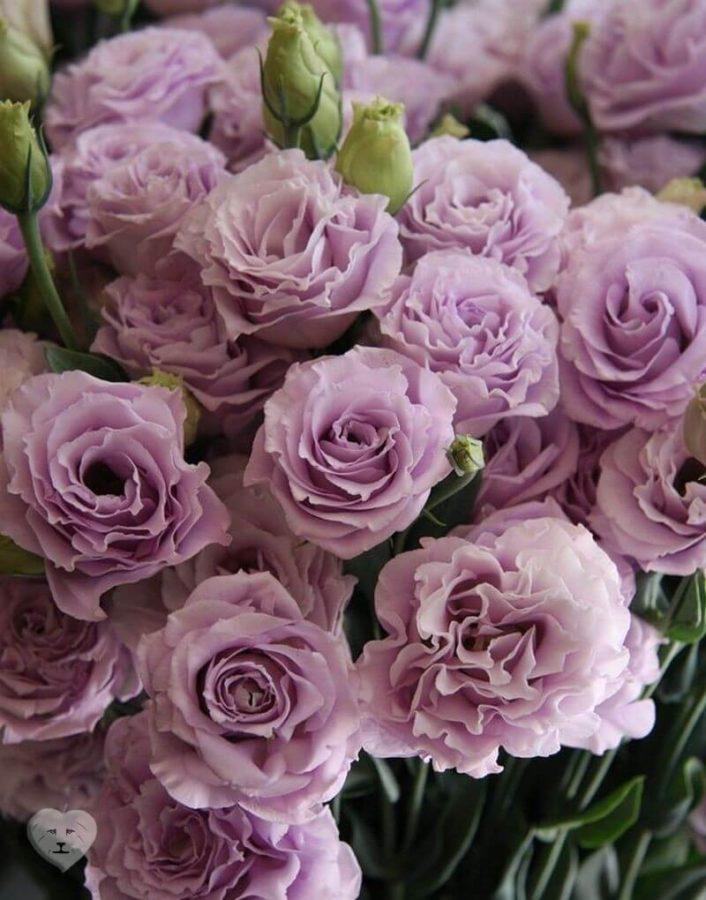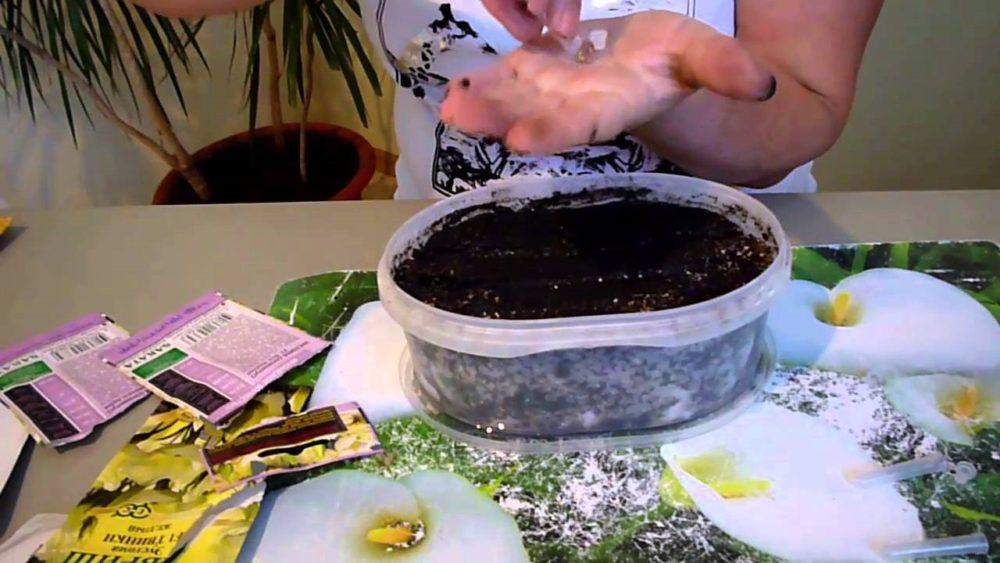What is the difference between planting and caring for eustoma in Siberia
 The homeland of the perennial eustoma is the US South with a subtropical climate. At the same time, successful planting and caring for eustoma in Siberia is quite possible. Here it is grown in pots as a perennial plant or in flower beds as an annual.
The homeland of the perennial eustoma is the US South with a subtropical climate. At the same time, successful planting and caring for eustoma in Siberia is quite possible. Here it is grown in pots as a perennial plant or in flower beds as an annual.
Planting and caring for eustoma in Siberia to obtain lush flowering

Seed sowing time
 The growing season of eustoma is about six months. So that it blooms in July, they are engaged in sowing seeds in December.
The growing season of eustoma is about six months. So that it blooms in July, they are engaged in sowing seeds in December.
Eustoma loves fertile, permeable soil with an acidity of 6-6.5. In more acidic soil, it grows slowly and develops poorly.
The soil is poured into a small container for seedlings and well spilled with water. The seeds are sown on the surface. Since the seeds germinate better in the light, they are not sprinkled with earth on top. Watering the seeds is done with warm water with the addition of a rooting agent.
It is desirable to dissolve the pelleted seed shell. Otherwise, they sprout for a very long time, or they may not ascend at all.
The container is covered with foil and left in a room with a temperature of 21-24 ° C. At higher temperatures, the development of plants is greatly delayed, a large rosette is formed, but they will not bloom this year.
To avoid waterlogging and get rid of condensation, the greenhouse is ventilated in the morning and evening. After the first shoots, the film is completely removed.
Transfer
 After the appearance of the third leaf, the eustoma is ready for picking.
After the appearance of the third leaf, the eustoma is ready for picking.
The pick should not be postponed for long. At a later date, the delicate roots of the eustoma grow strongly. When diving, they can be damaged and cause the death of the plant.
Eustoma is transplanted into large cups. For the period of adaptation, they are placed in a cool place, protected from sunlight. In the second half of June, stable weather sets in in Siberia, by this time about six leaves appear on the eustoma. Now it can be transplanted into a flower bed.
In a harsh climate, eustoma is best grown in pots... The roots of the plants are not very large, so there is no need to use a deep container. The pots are filled with a drainage layer by one third, and the top is covered with well-fertilized soil. The plant is transplanted together with the ground, being careful not to damage the roots. After transplanting, watered with warm water with the addition of a rooting agent and closed with cut plastic bottles.
Pinching
 The plant is pinched between 3 and 4 pairs of leaves. As a result, stepchildren grow from the axils of the remaining leaves, flower stalks develop, the stem is covered with luxurious, lush flowers. With the help of pinching, you can achieve the development of up to 20 peduncles.
The plant is pinched between 3 and 4 pairs of leaves. As a result, stepchildren grow from the axils of the remaining leaves, flower stalks develop, the stem is covered with luxurious, lush flowers. With the help of pinching, you can achieve the development of up to 20 peduncles.
Eustoma care in Siberia
 For the fruitful cultivation of eustoma in the harsh conditions of Siberia, after planting and rooting, careful care and attention to its needs are required.
For the fruitful cultivation of eustoma in the harsh conditions of Siberia, after planting and rooting, careful care and attention to its needs are required.
Watering
 Eustoma does not tolerate both prolonged drought and waterlogging. With prolonged drying of the soil, it often sheds its buds. She has a superficial root system, therefore, when growing, they carefully monitor the state of the upper layer of the soil and, when dry, watered immediately.
Eustoma does not tolerate both prolonged drought and waterlogging. With prolonged drying of the soil, it often sheds its buds. She has a superficial root system, therefore, when growing, they carefully monitor the state of the upper layer of the soil and, when dry, watered immediately.
Top dressing

Eustoma needs periodic fertilization:
- after sowing, as well as 10 days after germination to stimulate growth, it is fed Zircon or Epin;
- after a pick, use Heteroauxin;
- during the period of budding and flowering, eustoma needs phosphorus and potassium fertilizers.
The plant responds well to feeding, pleases with bright foliage and rich flowering.
Diseases and pests
 With the onset of the rainy season and cool weather, when grown in Siberia, eustoma is often affected by powdery mildew, fusarium, gray mold. Preventing the development of fungal diseases helps preventive treatments with basezol or any other antifungal drug.
With the onset of the rainy season and cool weather, when grown in Siberia, eustoma is often affected by powdery mildew, fusarium, gray mold. Preventing the development of fungal diseases helps preventive treatments with basezol or any other antifungal drug.
To protect eustoma from aphids and other pests, they are sprayed with Aktara or Prestige.
Wintering
 Most often in Siberia, eustoma seeds are planted in December and grown as an annual plant, with proper care during the warm period. However, if it is transplanted into pots for the winter, it will continue to delight with flowering next year.
Most often in Siberia, eustoma seeds are planted in December and grown as an annual plant, with proper care during the warm period. However, if it is transplanted into pots for the winter, it will continue to delight with flowering next year.
Pots with transplanted flowers are treated against insects and fungal diseases, and then brought into a room with a temperature of no more than 10 ° C.
Flowers are cut. During wintering, feeding is completely stopped. Eustoma is rarely watered. To retain moisture, sprinkle the earth with a small layer of sifted sand. The plant is in this form all winter, and already in March it blooms.
 Subject to the planting technology and careful care of the growing eustoma, its fruitful cultivation is possible in the harsh conditions of Siberia. Timely watering, top dressing, pinching and frost protection keep this luxurious plant flowering for several years.
Subject to the planting technology and careful care of the growing eustoma, its fruitful cultivation is possible in the harsh conditions of Siberia. Timely watering, top dressing, pinching and frost protection keep this luxurious plant flowering for several years.